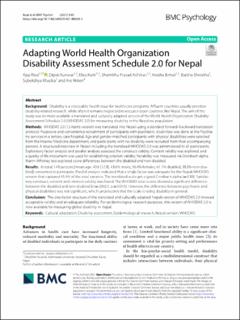| dc.contributor.author | Risal, Ajay | |
| dc.contributor.author | Kunwar, Dipak | |
| dc.contributor.author | Karki, Eliza | |
| dc.contributor.author | Adhikari, Shambhu Prasad | |
| dc.contributor.author | Bimali, Inosha | |
| dc.contributor.author | Shrestha, Barsha | |
| dc.contributor.author | Khadka, Subekshya | |
| dc.contributor.author | Holen, Are | |
| dc.date.accessioned | 2023-01-24T18:45:28Z | |
| dc.date.available | 2023-01-24T18:45:28Z | |
| dc.date.created | 2021-08-02T14:34:11Z | |
| dc.date.issued | 2021 | |
| dc.identifier.citation | BMC Psychology. 2021, 9 (1), 1-10. | en_US |
| dc.identifier.issn | 2050-7283 | |
| dc.identifier.uri | https://hdl.handle.net/11250/3046007 | |
| dc.description.abstract | Background Disability is a vital public health issue for health care programs. Affluent countries usually prioritize disability-related research, while often it remains neglected in resource-poor countries like Nepal. The aim of this study was to make available a translated and culturally adapted version of the World Health Organization Disability Assessment Schedule 2.0 (WHODAS 2.0) for measuring disability in the Nepalese population. Methods WHODAS 2.0 (12-items version) was translated into Nepali using a standard forward–backward translation protocol. Purposive and convenience recruitment of participants with psychiatric disabilities was done at the Psychiatry services in a tertiary care hospital. Age and gender-matched participants with physical disabilities were selected from the Internal Medicine department, and participants with no disability were recruited from their accompanying persons. A structured interview in Nepali including the translated WHODAS 2.0 was administered to all participants. Exploratory factor analysis and parallel analysis assessed the construct validity. Content validity was explored, and a quality of life instrument was used for establishing criterion validity. Reliability was measured via Cronbach alpha. Mann–Whitney test explored score differences between the disabled and non-disabled. Results In total, 149 persons [mean age: 40.6 (12.8); 43.6% males, 56.4% females; 61.7% disabled, 38.3% non-disabled] consented to participate. Parallel analysis indicated that a single factor was adequate for the Nepali WHODAS version that captured 45.4% of the total variance. The translated scale got a good Cronbach alpha (= 0.89). Satisfactory construct, content and criterion validity was found. The WHODAS total scores showed a significant difference between the disabled and non-disabled (U = 2002.5; p = 0.015). However, the difference between psychiatric and physical disabilities was not significant, which underscores that the scale is rating disability in general. Conclusion The one-factor structure of the translated and culturally adapted Nepali-version of WHODAS 2.0 showed acceptable validity and an adequate reliability. For epidemiological research purposes, this version of WHODAS 2.0 is now available for measuring global disability in Nepal. | en_US |
| dc.language.iso | eng | en_US |
| dc.rights | Navngivelse 4.0 Internasjonal | * |
| dc.rights.uri | http://creativecommons.org/licenses/by/4.0/deed.no | * |
| dc.title | Adapting World Health Organization Disability Assessment Schedule 2.0 for Nepal | en_US |
| dc.title.alternative | Adapting World Health Organization Disability Assessment Schedule 2.0 for Nepal | en_US |
| dc.type | Journal article | en_US |
| dc.type | Peer reviewed | en_US |
| dc.description.version | publishedVersion | en_US |
| dc.source.pagenumber | 1-10 | en_US |
| dc.source.volume | 9 | en_US |
| dc.source.journal | BMC Psychology | en_US |
| dc.source.issue | 1 | en_US |
| dc.identifier.doi | 10.1186/s40359-021-00550-5 | |
| dc.identifier.cristin | 1923467 | |
| cristin.ispublished | true | |
| cristin.fulltext | original | |
| cristin.qualitycode | 1 | |

